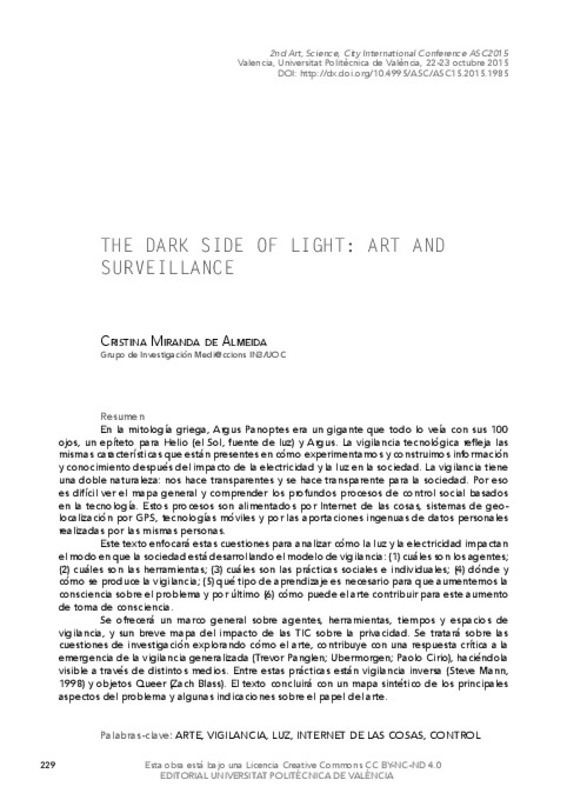JavaScript is disabled for your browser. Some features of this site may not work without it.
Buscar en RiuNet
Listar
Mi cuenta
Estadísticas
Ayuda RiuNet
Admin. UPV
THE DARK SIDE OF LIGHT: ART AND SURVEILLANCE
Mostrar el registro sencillo del ítem
Ficheros en el ítem
| dc.contributor.author | Miranda de Almeida, Cristina
|
es_ES |
| dc.date.accessioned | 2017-07-20T09:46:35Z | |
| dc.date.available | 2017-07-20T09:46:35Z | |
| dc.date.issued | 2015-11-17 | |
| dc.identifier.isbn | 9788490484562 | |
| dc.identifier.uri | http://hdl.handle.net/10251/85532 | |
| dc.description.abstract | [EN] In Greek mythology, Panoptes was an all-seeing giant, with a hundred eyes, an epitet for Helius (the Sun, source of light) and Argus. Surveillance processes reflect the very complex features of how information and knowledge are being processed in the global society after the impact of electricity and light. Surveillance has a double nature: it makes ourselves transparent and it makes itself transparent to us. Therefore, it is difficult to see the broad map and to understand the deep processes of technology-based control going on in society. These processes are fed by Internet of Things, GPS-based tracking systems, mobile technologies and by the very contribution of personal data from society in a naïve mode. This text will focus on these questions to analyse how light/ electricity impacted the way society is developing the dominant surveillance model: (1) who are the agents; (2) which are the tools; (3) which are the individual and social practices; (4) where and when does surveillance take place; (5) which kind of literacy is required to raise awareness about global surveillance and lastly, (6) how art can contribute to raise awareness in society. A general framework about the features, agents, tools, times and spaces of surveillance (a brief map of the impact of ICT and light on privacy) will be offered. Focusing on the core of the research questions we will explore how art is a critical response to the rise of surveillance and making surveillance processes visible (Trevor Panglen; Ubermorgen; Paolo Cirio), in different media (videos, installations, performances and critical objects). Among these art practices are inverse surveillance and reflexivity (Stephen Mann 1998) and Queer Objects (Zach Blass). The presentation will conclude with a synthetic map of the main aspects of the problem and a few indications about the role of art. | es_ES |
| dc.description.abstract | [ES] En la mitología griega, Argus Panoptes era un gigante que todo lo veía con sus 100 ojos, un epíteto para Helio (el Sol, fuente de luz) y Argus. La vigilancia tecnológica refleja las mismas características que están presentes en cómo experimentamos y construimos información y conocimiento después del impacto de la electricidad y la luz en la sociedad. La vigilancia tiene una doble naturaleza: nos hace transparentes y se hace transparente para la sociedad. Por eso es difícil ver el mapa general y comprender los profundos procesos de control social basados en la tecnología. Estos procesos son alimentados por Internet de las cosas, sistemas de geolocalización por GPS, tecnologías móviles y por las aportaciones ingenuas de datos personales realizadas por las mismas personas. Este texto enfocará estas cuestiones para analizar cómo la luz y la electricidad impactan el modo en que la sociedad está desarrollando el modelo de vigilancia: (1) cuáles son los agentes; (2) cuáles son las herramientas; (3) cuáles son las prácticas sociales e individuales; (4) dónde y cómo se produce la vigilancia; (5) qué tipo de aprendizaje es necesario para que aumentemos la consciencia sobre el problema y por último (6) cómo puede el arte contribuir para este aumento de toma de consciencia. Se ofrecerá un marco general sobre agentes, herramientas, tiempos y espacios de vigilancia, y sun breve mapa del impacto de las TIC sobre la privacidad. Se tratará sobre las cuestiones de investigación explorando cómo el arte, contribuye con una respuesta crítica a la emergencia de la vigilancia generalizada (Trevor Panglen; Ubermorgen; Paolo Cirio), haciéndola visible a través de distintos medios. Entre estas prácticas están vigilancia inversa (Steve Mann, 1998) y objetos Queer (Zach Blass). El texto concluirá con un mapa sintético de los principales aspectos del problema y algunas indicaciones sobre el papel del arte. | es_ES |
| dc.format.extent | 7 | es_ES |
| dc.language | Inglés | es_ES |
| dc.publisher | Editorial Universitat Politècnica de València | es_ES |
| dc.relation.ispartof | Actas Segundo Congreso Internacional Arte Ciencia Ciudad ACC2015 | es_ES |
| dc.rights | Reconocimiento - No comercial - Sin obra derivada (by-nc-nd) | es_ES |
| dc.subject | Arte | es_ES |
| dc.subject | Ciencia | es_ES |
| dc.subject | Ciudad | es_ES |
| dc.subject | Visualidad | es_ES |
| dc.subject | Energía | es_ES |
| dc.subject | Conectividad | es_ES |
| dc.subject | Luz | es_ES |
| dc.subject | Oscuridad | es_ES |
| dc.title | THE DARK SIDE OF LIGHT: ART AND SURVEILLANCE | es_ES |
| dc.type | Capítulo de libro | es_ES |
| dc.type | Comunicación en congreso | es_ES |
| dc.rights.accessRights | Abierto | es_ES |
| dc.description.bibliographicCitation | Miranda De Almeida, C. (2015). THE DARK SIDE OF LIGHT: ART AND SURVEILLANCE. En Actas Segundo Congreso Internacional Arte Ciencia Ciudad ACC2015. Editorial Universitat Politècnica de València. 230-237. http://hdl.handle.net/10251/85532 | es_ES |
| dc.description.accrualMethod | OCS | es_ES |
| dc.relation.conferencename | 2º Congreso Internacional ACC: Arte, Ciencia, Ciudad | es_ES |
| dc.relation.conferencedate | October 22-23,2015 | es_ES |
| dc.relation.conferenceplace | Valencia, Spain | es_ES |
| dc.relation.publisherversion | http://ocs.editorial.upv.es/index.php/ASC/ASC15/paper/view/2043 | es_ES |
| dc.description.upvformatpinicio | 230 | es_ES |
| dc.description.upvformatpfin | 237 | es_ES |
| dc.type.version | info:eu-repo/semantics/publishedVersion | es_ES |
| dc.relation.pasarela | OCS\2043 | es_ES |






